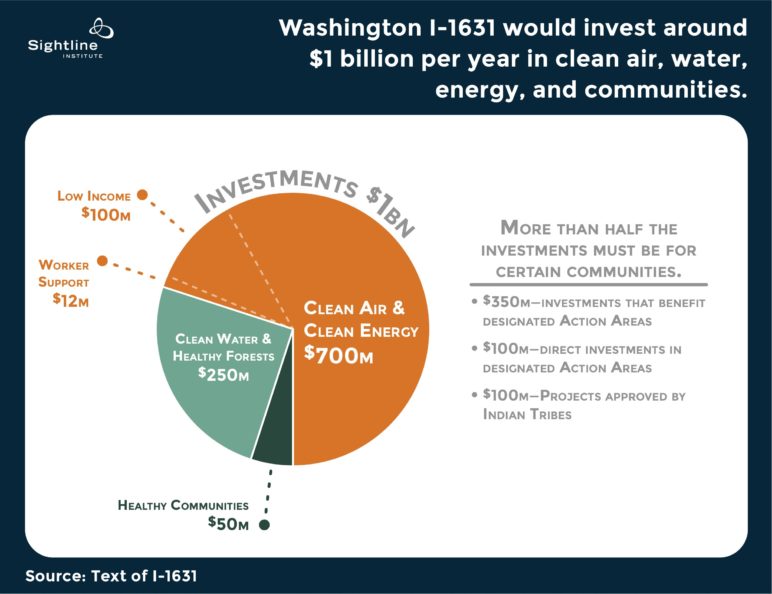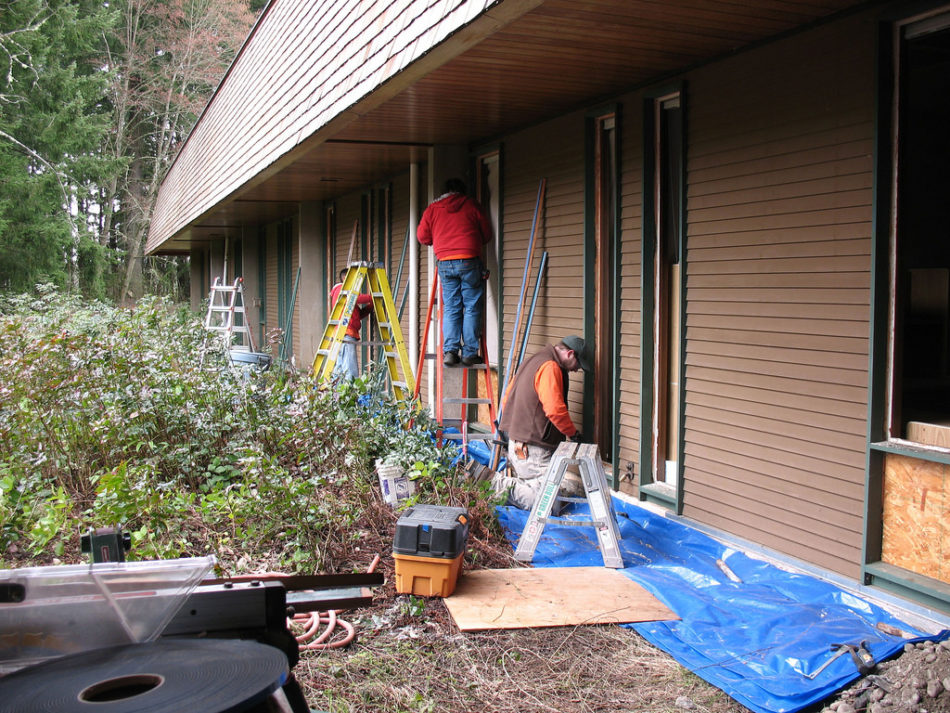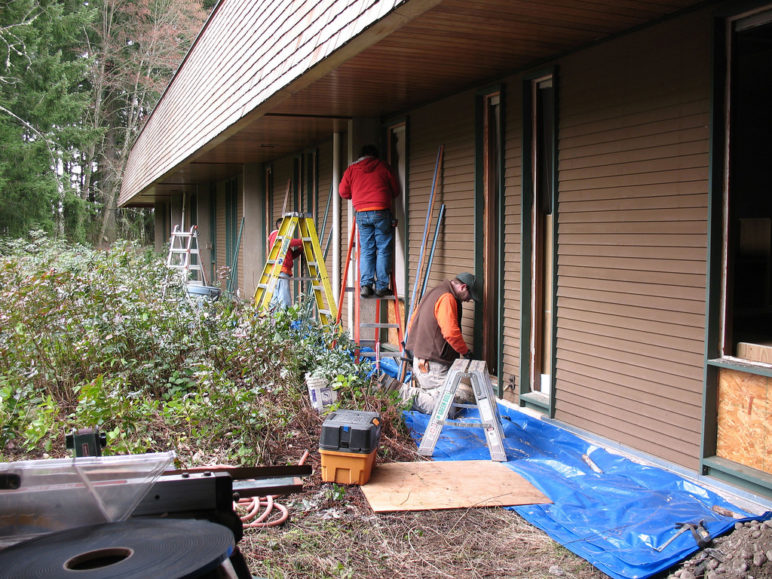When a ballot initiative touts raising a whopping $1 billion per year for the foreseeable future, voters understandably want to know how the money will be spent. In a previous article, we showed what Initiative 1631 could provide for rural areas of Washington. But what about cities and suburbs? In the coming decade, I-1631 could direct billions of dollars into building energy efficiency retrofits, solar rooftop installations, electric vehicles and charging infrastructure, affordable housing along transit corridors, tree planting and green stormwater projects.
That $1 billion would come from charging the state’s big polluters a fee for producing carbon dioxide via fossil fuel use. The initiative requires at least 70 percent of revenue to go toward “clean air and clean energy” projects that reduce greenhouse gas emissions. The remaining 30 percent must be invested in clean water, healthy forests, and healthy communities.

Original Sightline Institute graphic, available under our free use policy.
Investments in Homes, Buildings, and Schools
The cheapest energy is the energy you don’t use. Washington has long been a leader in energy efficiency and I-1631 could scale up state programs with proven success. Take the Washington home weatherization program coordinated by the Department of Commerce. Last year, it weatherized 2,540 low-income homes, which will pass on savings to residents’ annual utility bills.
Scaled up, these savings are substantial. Nine northeastern states created a program nearly a decade ago called the Regional Greenhouse Gas Initiative (RGGI) to charge polluters and invest the revenue. In 2016, RGGI states invested about $230 million in energy efficiency programs and expect to see a return of $822 million in lifetime energy bill savings to over 176,000 households and 2,430 businesses.
Other than homes and businesses, public facilities—and the taxpayers who fund them—could benefit from energy efficiency. For instance, Port Orchard recently received $350,000 from the state to help pay for energy efficiency upgrades to local government buildings. This type of energy efficiency program could be replicated around the state to save local governments money on utility bills and create thousands of jobs.
The same concept applies to schools. Washington school boards want to install solar energy around the state. For example, the Helen Keller Elementary School in Kirkland recently installed a 10-kilowatt solar array. On-site solar, paired with energy storage, could enable schools to be more self-sufficient. Carbon pricing revenues could be used to make many more solar school projects feasible in the future.
Investments in Transportation and Public Transit
Since gasoline and diesel fuel account for the largest portion of Washington’s greenhouse gas emissions, this sector would likely get significant funding under I-1631. Representative investments could include:
- Funds to transition public transit fleets to electric or other cleaner fuels. King County is leading the way by already committing to purchase 120 electric buses by 2020. I-1631 could help King County accelerate conversion of its fleet, as well as speed up transitions in other urban transit agencies like Tacoma (Pierce Transit), Spokane (Spokane Transit) and Vancouver (C Tran).
- Funds to transition school bus fleets to electric or other cleaner fuels. No schools in Washington State have so far invested in electric school buses but Sacramento, California, used carbon pricing revenues last year to invest in 29 electric school buses—the largest investment to date in the nation. As that technology matures, more districts will invest in them.
- Rebates or other funding incentives to Washington drivers to invest in all-electric or plug-in hybrid electric vehicles (plug-in vehicles have longer ranges than all-electric because they run on a combination of electricity and gasoline). More than 150,000 California drivers were already issued similar rebates under the California carbon pricing program.
Investments in Affordable Housing
With the increased urgency to build affordable housing in Washington State, I-1631 could play an integral role in financing everything from Accessory Dwelling Units (ADUs) to large housing projects. Small units, including ADUs, have a smaller carbon footprint and could be built to higher energy efficiency standards to significantly reduce tenants’ utility bills. Larger affordable housing developments along transit corridors could also reduce greenhouse gas emissions. For instance, a 44-unit affordable housing development in Tulare County, California, was built with assistance from carbon revenues. It integrated vanpooling service, rooftop solar, and discount transit passes to low-income residents. Over 1,600 housing units have so far been built with carbon revenues in California.
Investments to Green the Natural Environment
Investments in urban forests and neighborhood tree canopies are another possibility under I-1631. Trees capture and hold carbon dioxide, reduce the “heat island” effect of urban communities, and conserve water. Clark County started a program in 2017 to plant hundreds of trees and expand its urban tree canopy by more than a dozen acres. Such a program could be expanded and replicated around the state. Again, California serves as a model, where carbon revenues are enabling dozens of urban tree-planting programs. In Stockton, California, over 1,200 new trees are being planted in disadvantaged communities.
Green stormwater investments could also proliferate under I-1631. These green investments reduce water use and save money on construction, maintenance, and electricity costs as compared to older techniques. Just north of Sea-Tac, in Burien, lies the Northeast Redevelopment Area, a 135-acre area rezoned and reconstructed to support Sea-Tac International Airport. Its design includes green infrastructure techniques to reduce stormwater pollution, as well as recreational biking and hiking opportunities along Miller Creek. These types of projects are difficult for cities to finance and I-1631 could help them move forward around the state.
Benefits for Urban Washington
There is an ever-increasing need in Washington’s cities and suburbs for public and private investment in projects to reduce climate impacts, improve quality of life, make communities more resilient, and create economic opportunities and jobs. I-1631 would create billions of dollars for such investments. As evidenced by other polluters-pay programs across North America, the returns could have profound and lasting positive impacts on Washington’s urban communities.











Marty Bishop
I am interested in composting food waste in Kitsap county. Is the Cedar Grove model in Seattle working well?
Chris Covert-Bowlds
I-1631, good for our kids, health, air, jobs, economy, forests, and future. Vote as if your health and your kids depend on it, they do! http://www.yeson1631.org